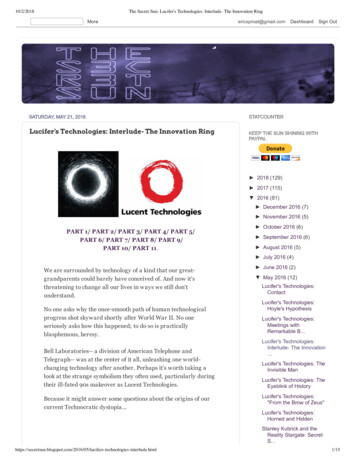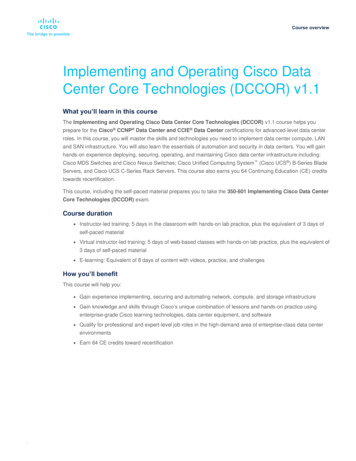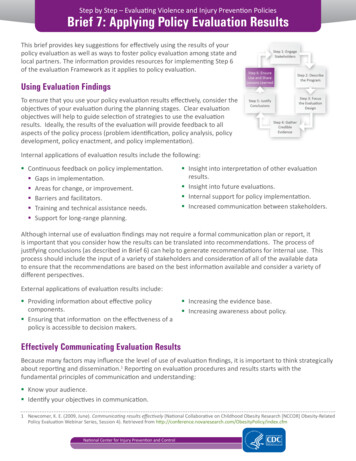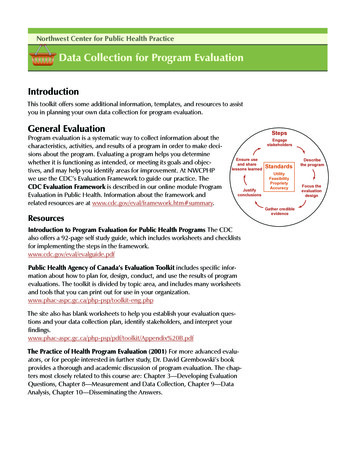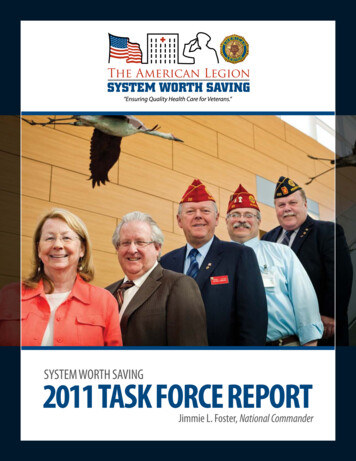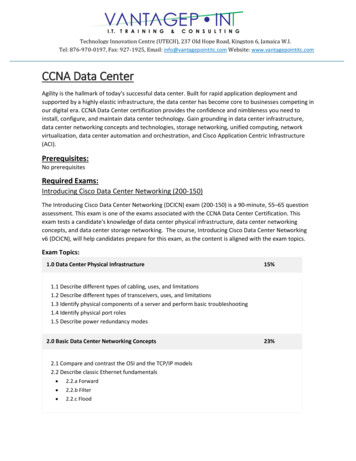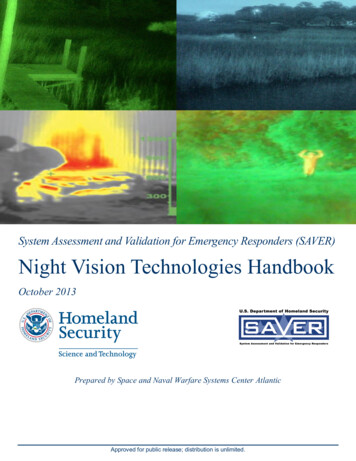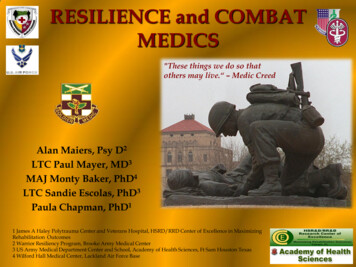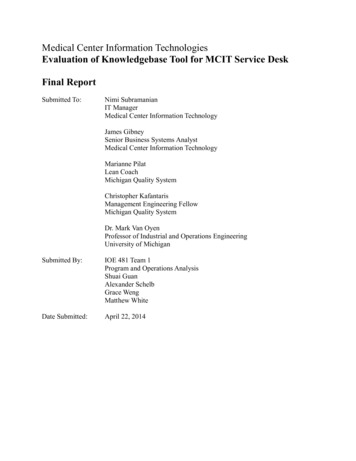
Transcription
Medical Center Information TechnologiesEvaluation of Knowledgebase Tool for MCIT Service DeskFinal ReportSubmitted To:Nimi SubramanianIT ManagerMedical Center Information TechnologyJames GibneySenior Business Systems AnalystMedical Center Information TechnologyMarianne PilatLean CoachMichigan Quality SystemChristopher KafantarisManagement Engineering FellowMichigan Quality SystemDr. Mark Van OyenProfessor of Industrial and Operations EngineeringUniversity of MichiganSubmitted By:IOE 481 Team 1Program and Operations AnalysisShuai GuanAlexander SchelbGrace WengMatthew WhiteDate Submitted:April 22, 2014
Table of ContentsList of Tables & Figures .3Executive Summary .4Introduction .7Background .7Service Desk Tiers .8Key Issues .8Goals and Objectives .9Scope .9Methods .10Observations .10Phone Data Pull.10Interviews .10Survey .10Knowledgebase Tool Research . 11Findings. 11Observations . 11Interviews . 11Phone Data Pull.12Survey .13Knowledgebase Tool Research .15Conclusions .16Knowledgebase Tool .17Training Program .17Standard Communication Procedures .17Job Variability .17Recommendations .17Standardized Knowledgebase Tool .17Standardized Training Program .17Standard Communication Procedures .18Self-Service .18Expected Impact .18Using RightAnswers as the Single Standardized Knowledgebase Tool .18Standardized Training Program for Knowledgebase Tool Use .18Standardized Communication Procedures .19Future Project Considerations .19MCIT Service Desk and Service Provider Collaboration .19Medical School Information Services Service Desk .19Further Analysis into Remedy Knowledge Management and RightAnswers Tool .20i
List of Tables & FiguresFigure 1Process Map .8Figure 2Calls Handled Distribution: Tier 1 .12Figure 3Calls Handled Distribution: Tier 2 .12Figure 4Call Percentages by Class .13Figure 5Tools Utilization Frequency Index .14Figure 6Knowledgebase Tools Features Preferences Index .15Table 1Search Features Checklist .16Table 2Editing Features Checklist .16Table 3Reporting Features Checklist .16ii
Executive SummaryThe Medical Center Information Technology (MCIT) Service Desk is a customer service callcenter for the University of Michigan Health System (UMHS) that addresses IT issues. Whenemployees of UMHS run into technical issues, they call the MCIT Service Desk. In order tosolve these issues, the Service Desk staff have several Knowledgebase tools that containinformation relating to the various types of issues they may face and the steps to resolve theissues at hand. After observing the current state of the MCIT Service Desk and determining thekey issues facing the department, the team has identified and developed conclusions, and hasmade recommendations to improve the Service Desk operations.BackgroundThe MCIT Service Desk currently runs a two Tier system. Tier 1 typically takes calls pertainingto general issues, such as a password reset or the configuration of a service such as MicrosoftOutlook. Tier 2 primarily deals with calls pertaining to specific clinical systems in use at theUniversity of Michigan Hospital (CareLink, CareWeb, MiChart). After 7 PM only Tier 2 is stilloperating. Between the hours of 7 PM and 7 AM, Tier 2 accepts calls typically routed to Tier 1,in addition to managing their normal call types.When a customer calls the Service Desk, support staff members create a ticket for that call. Theticket includes information on who handles the call, the primary issue being reported, theresolved or unresolved status of the ticket, and a work log that tracks the states of the ticket sinceit was created.How Service Desk staff resolve caller s questions varies depending on the staff member. ServiceDesk staff reference at least seven Knowledgebase tools to resolve various caller questions.These include Confluence, SharePoint, OneNote, and a MiChart Reference Page. Less formaloptions are requesting support from a colleague who is not currently on a call, referencing pastemails and tickets, and searching Google. If the Service Desk teams cannot resolve a call, theticket is passed to a Service Provider team. This includes groups such as the Desktop SupportTeam, Identity Management Team, and the Service Management Teams that can handle morespecific customer issues.Service provided varies because Service Desk staff use different tools and processes to resolvecalls. While the Service Desk currently meets their call volume and customer satisfaction isabove the industry average, room for improvement and standardization of the problem solvingprocess still exists.The main goal of this project is to provide recommendations which will allow for simplerutilization of the Service Desk’s Knowledgebase tools in order to provide more consistentcustomer service. With a constant level of service, customers calling the Service Desk can expectto encounter higher first-round call resolution and fewer call handoffs between Service Providerteams.MethodsThe team performed five data collection methods to evaluate the current state of the MCITService Desk.1
-----Observed within the MCIT Service Desk teams. The team performed over 16 hours ofobservations between the two Tiers on how the Service Desk Staff currently usesKnowledgebase tools.Interviewed personnel within the MCIT Department. The team interviewed several keyService Desk Staff, Service Provider Team Staff and Managers, MCIT Directors, andExecutive Directors throughout the course of the project to understand all Service Deskneeds from different organizational levels.Collected phone system data. The Service Desk Analysis Team provided phone systemdata on the 33,403 calls received by Tier 1 and the 23,935 received by Tier 2 betweenOctober 1 and December 31 of 2013. The data regarding the types of phone calls receivedwas used to further the current state analysis.Conducted surveys of MCIT Service Desk Staff. The team developed a survey that wascompleted by 20 out of the 25 Service Desk staff members to determine how and why staffuse the Knowledgebase tools available to them.Knowledgebase tool research. The team researched 5 different Knowledgebase tools anddeveloped a decision matrix with feature weights based on survey responses. Some of thetools are currently in use by the Service Desk, and some are not.FindingsObservations with Tier 1 and Tier 2 of the MCIT Service Desk, and observation at MSISprovided information into the current state of the Service Desks. Observations showed MCITService Desk staff resolve calls differently, using different tools. MSIS observation allowed theteam to draw parallels between the two and also introduced the team to Everyday Lean Ideas(ELIs) in practice.Phone data showed that password resets and account lockouts combine for 9.3% of total calls,while information requests and user education combine for 9.04% of calls. Call volume alsodecreases as a typical week progresses, with Monday averaging 23.8% more calls than Friday inTier 1 and 12.8% more in Tier 2. Weekends average 52% less calls per day compared toweekdays in Tier 2.Survey results from the Service Desk staff show that 70% of the staff were trained through ashadowing process. Also, 75% of staff choose to use the same Knowledgebase tools as the staffmember that they shadowed in training. Staff members only have a 60% confidence level thatinformation they require to resolve a service call is located within the Knowledgebase tool theyuse.The team was able to quantify through surveys that the staff would prefer to have oneKnowledgebase tool, and the features that should be in such a tool. Regarding function, theability to search key words is highly preferred. Staff desire search options for when they attemptto find documented solutions. Through interviews, staff regularly noted password or networkrequirements to access the tool, hyperlinks within articles, and the ability to add documents toarticles as being important to the Knowledgebase tool function. Comparing each candidate toolthrough decision matrices regarding search, edit, and reporting features, it was determined thatRightAnswers matched the majority of the staff members’ preferences.2
ConclusionsHaving one Knowledgebase tool in particular that is utilized, instead of the wide varietycurrently in use, would make the updating and maintenance of said tool much easier. With MSISand MCIT Service Desks using different tools for ticket handling, one common Knowledgebasetool will assist them to handle calls consistently. Focusing on one tool would allow for each staffmember to be confident that the information they need to resolve a customer’s issue is easilyaccessible, and that they can provide a consistent level of service to each caller.The majority of the training for new staff members is done by shadowing an existing staffmember, which allows for important information to potentially be missed. As most staffmembers use varying methods to resolve customer questions, a standardized training processcould effectively ensure that all staff members have the same level of understanding regardingthe use of each Knowledgebase tool.Due to the fact that approximately 18% of calls the Service Desk staff encounter relate toproblems that are quickly and easily remedied, a large portion of time could be freed up if theseissues did not require Service Desk staff to resolve. With a self-service option on the ServiceDesk website, customers could deal with these issues themselves, giving the Service Desk stafftime to focus on updating and maintaining their Knowledgebase tools. This would also allowtime for weekly staff meetings regarding new issues that may have not been dealt with before.RecommendationsBased on these Findings and Conclusions, the team recommends the following:- Use RightAnswers as the central Knowledgebase tool. Provide staff with single toolto encourage staff to use the same processes for resolving issues which will promoteconsistent service to end users.- Standardized training process. Define and implement MLearning training modulesand internal training for proper use of the Knowledgebase tools for new staff prior toshadowing process. Annual refresher modules for current staff to maintain bestpractices when using Knowledgebase tool.- Standardized information communication process. Weekly meetings between allService Desk staff and daily meeting during shift changes will ensure information isupdated and all staff members are current on the state of the Service Desk.Information regarding new problems confirmed with the corresponding ServiceProvider to ensure information being stored in the Knowledgebase is accurate and upto date. Implement Everyday Lean Ideas (ELIs) board to document and track issueresolutions.- Future Projects. An IOE 481 project evaluating and defining standard collaborationbetween the MCIT Service Desk and Service Providers is recommended for a futuresemester, in order to reduce the workload of the Service Providers in addition toassisting MCIT and MSIS Service Desk staffs in their problem solving process.3
IntroductionThe Medical Center Information Technology (MCIT) Service Desk is a customer service centerfor the University of Michigan Health System (UMHS) that deals with IT issues. Whenemployees of UMHS run into technical issues, they call the MCIT Service Desk to help resolvetheir problem. These problems can include anything from a forgotten password to morecomplicated problems, such as hardware issues. In order to solve these issues, the Service Deskstaff consult several Knowledgebase tools. These tools are databases that relate to various ITissues. Knowledgebase tools contain documented steps to correct these issues, and other relevantinformation. Currently, the Service Desk staff utilize several different Knowledgebase tools, eachcontaining a different level of information, which allows for varying strategies used whenanswering a call. The IT Manager asked IOE 481 1 Team from the University of Michigan tostudy the current state of the MCIT Service Desk and make recommendations to improve itscurrent use of the Knowledgebase tools. From observations and analysis, the team has developedrecommend changes to the MCIT Department to allow for standardized work processes andconsistent service.The purpose of this report is to provide a background on the MCIT Service Desk, present the keyissues facing the department, describe the methodology utilized by the team to identify anddevelop conclusions, as well as presenting the team’s recommendations to the department. Thisreport will also describe the expected impact of these recommendations on the MCIT ServiceDesk.BackgroundIn order to understand the key issues facing the Service Desk and its staff, a more detaileddescription of the Service Desk itself must be presented. When a customer calls the ServiceDesk, support staff members create what is referred to as a ticket for that call. The ticket includesall the information of each call, which includes, but is not limited to, who handles the call, theprimary issue being reported, if the call is completed or still needs to be resolved, and a work logthat tracks what has been done with the ticket since it was created. The Service Desk currentlyoperates on a two Tier basis, each with specific call types to be resolved. Figure 1 outlines thecurrent process map for the MCIT Service Desk.4
Figure 1: Process MapDue to the variety of methods Service Desk staff use to resolve customer issues, the level ofservice provided is variable. While the Service Desk currently meets their call volume andcustomers are generally satisfied with their results, room for improvement and standardization ofthe problem solving process still exists.Service Desk TiersTier 1 operates from 7 am to 7 pm, Monday through Friday, and typically takes calls pertainingto more general issues, such as a password reset or the configuration of a service such asMicrosoft Outlook. Tier 2 operates 24 hours a day, 7 days a week, and primarily deals with callspertaining to specific clinical systems in use at the University of Michigan Hospital (CareLink,CareWeb, MiChart). After hours, however, Tier 2 will accept calls typically routed to Tier 1, inaddition to managing their normal calls.If Tiers 1 or 2 cannot resolve a call, it may be passed along to a Service Provider team. Thisincludes groups such as the Desktop Support Team, which will go to the caller’s location andphysically deal with the issue, if it cannot be resolved over the phone. Other Service Providerteams also include the Identity Management Team, the Service Desk Analysis Team, and ServiceManagement teams.Key IssuesCurrently, the Service Desk staff are able to effectively handle the volume of calls they receive;however, as the Client reported, the manner in which staff members are resolving the questionsof callers is a main concern. Presently, Service Desk staff reference at least seven sources ofinformation to resolve various caller questions. These include, but are not limited to: Confluence SharePoint5
OneNote MiChart Reference PageOther, less standardized methods include: Requesting support from a colleague who is not currently on a call Referencing past emails and tickets Utilizing Google’s search functionThe following key issues as reported by the Client are driving the need for this project: Process:o Different staff members use different Knowledgebase tools to answer questionso Knowledgebase tools are infrequently updatedo Tier 1 and Tier 2 are not physically located near each othero There is no standard communication flow between staff members Constraintso The physical locations of Tier 1 and Tier 2 are set; location merging will not beconsideredo Call volume throughout the day should be maintainedGoals and ObjectivesIn order to study the current state of the MCIT Service Desk and make effective and accuraterecommendations to improve its current Knowledgebase tools and associated processes, the teamhas performed the following tasks: Observation and study of the general process of answering service calls Distribution and analysis of a survey for Service Desk staff Root cause analysis to identify the current areas for improvement within the MCITService DeskWith this information, the team has developed recommendations to: Standardize the process of completing a service call Standardize a singular Knowledgebase tool used by Service Desk staff Standardize the training process for both current and new staff members Develop a new process for updating the MCIT Knowledgebase tools Increase Service Desk staff and caller satisfactionScopeThis project focuses on working with Tier 1 and Tier 2 Service Desk staff to understand thecurrent state of how they resolve service calls. This includes the process they follow to resolve acall, how they use the Knowledgebase tools available to them, and how they work withcolleagues to communicate information. The final deliverables include the designs forcompleting a service call and Knowledgebase tools that will help establish a more consistentprocess and information flow.Anything not directly related to the Service Desk staff, their individual performance measures,and the merging of the two Tier locations is considered outside of the scope of this project. Whilethe MSIS is not directly in scope of the project, the team saw value in benchmarking with themto draw parallels between MCIT and MSIS Service Desks.6
MethodsIn order to gain a better understanding of how the MCIT Service Desk functions, the teamconducted observations, received and analyzed a phone system data pull, performed interviews,conducted and analyzed a survey, and then researched potential Knowledgebase tools that wouldfulfill the Service Desk staff needs.ObservationThe team has completed 16 hours of observation on Service Desk Tiers 1 and 2. The team hasalso completed 6 hours of observation on the MSIS Service Desk, in order to draw parallelsbetween the MCIT and MSIS work processes and inspire future project considerations.Observations held at MSIS are considered outside the scope of the project, but were used to seehow service calls are resolved from a different point of view.Phone Data PullThe team requested phone system data from the MCIT Service Desk Analysis team. This datawas received on February 15, 2014, and includes: Average time to answer a call in the queue Total number of calls that entered the queue Number of abandoned phone calls Number of calls routed to a different support group Top 10 most frequent issues resolved by the Service DeskThe data received has been analyzed to determine what type of call Service Desk staff mostfrequently fields. In this way, the team has ascertained the peak calling time and subject, as wellas defined procedures for short questions.InterviewsThroughout the timeline of the project, the team met with and interviewed various members ofthe MCIT staff from various departments. These groups included executives and managers, aswell as Service Desk staff. The information gathered during these interviews has allowed theteam to compile a list of features that various groups would like to see in the finalKnowledgebase recommendation.The team also interviewed various Service Providers, such as the Desktop Support and IdentityManagement teams. Even though Service Providers are not a direct part of the MCIT ServiceDesk, they are the teams that solve more complex problems passed along from the Service Desk.SurveyAs this project is heavily based on the Knowledgebase tools the staff use, the team created asurvey asking the Service Desk staff questions on each of the Knowledgebase tools to betterdetermine which is the most suitable Knowledgebase tool for each staff member’s specific needs.The input of the IT Manager and Team Coordinators helped to design the questions in order todesign a survey that captures quantitative and qualitative information on how the Service Deskstaff performs their work. By analyzing the survey responses, the team gained a greater insightfor making recommendations regarding work process and training standardization, along with an7
appropriate recommendation for a common Knowledgebase tool. This survey also allowed thestaff members to voice their opinions on potential changes, along with improving their worksatisfaction. In turn, this will allow customers calling the Service Desk to have a more satisfyingexperience. 21 out of the 25 staff members completed the survey.Knowledgebase Tool ResearchOnce the survey data was analyzed to determine the most important features staff desire in aKnowledgebase tool, the team researched 5 different tools in order to make a recommendation onwhat tool the staff should adopt. The tools researched were Atlassian Confluence, MicrosoftOneNote, Microsoft SharePoint, BMC Remedy Knowledge Management, and RightAnswerstools. All research was collected using each company’s resources for the most recent version ofthe software. Sources were the company websites, tool’s user guides and datasheets.FindingsObservationsThe IOE 481 team 1 conducted 16 hours of observations in Tier 1 and Tier 2. Currently, callvolume is considered by staff and managers as not being an issue. The Service Desk staff arecurrently able to answer and resolve the incoming calls they receive.Each staff member resolve customer calls in their own way. Observed practices to resolve a callwere using the One-Note and Confluence tools, using multiple internet reference page tabsopened on a desktop, and using a personal system of old emails and documents in Outlook.Many staff members in both Tiers had stated that there is limited Knowledgebase tool trainingprograms. Training for the position is a shadowing process. The first week of shadowing, thenew staff watch as an experience staff member resolve incoming calls. The second week oftraining is the new staff taking calls with the experienced member watching them.Updating the content within Knowledgebase tools was different amongst Service Desk staff. Thegeneral practice was noting what was needing change and making a personal note of it. Thisranged from making a mental note to a sticky-note placed on their desktop. There was minimalobservable communication regarding changes being made within the tools.Observation held at MSIS showed they are using a single Knowledgebase tool, the University ofMichigan Medical School (UMMS) Confluence. They also utilize an Everyday Lean Ideas(ELIs) wall where they document issues they seen, the steps that have been taken towards aresolution, and a final documentation of the issue’s solution.InterviewsThe IOE 481 team 1 conducted 8 interviews with Service Desk staff, managers, and directorswithin the MCIT department. These interviews help to understand the department’s experienceand expectation on the MCIT Service Desk.Interviews with MCIT Managers and Directors gave further insight into functions theKnowledgebase tool should contain from a managerial standpoint. The Identity Managementteam deals with the integration of Knowledgebase tools from a security point of view, noting that8
it is important a Knowledgebase tool should not be completely accessible to the general public ifit contains sensitive information.MCIT has begun some self-service options for end users to resolve issues themselves rather thancall into the Service Desk. Interviews revealed there is interest amongst the Managers andDirectors to further this practice, and was further supported when interviewing Service Providerteam members. This self-service should act as a way to train the end users instead of relying onService Desk staff.The Identity Management team also suggested an information validation process with ServiceProviders before publishing articles on the Knowledgebase tools. The Service Provider teamconfirmed that Service Desk update the articles on their Knowledgebase tool themselves. Thismakes for content within the tool to not always be the best solution. The team also suggestedhaving a verification process with them to ensure content is correct and the best practice toresolve a call. This would also involve increased communication between the MCIT ServiceDesk and the Service Provider teams.Phone Data PullThe phone data from each Tier revealed the call volume for each workday, which will be used tobetter understand how the Service Desk staff are spending the majority of their time throughoutthe week:Tier 1 Calls Handled DistributionCumulative call volumeOctober 1, 2013 - December 31, 00020000MondayTuesdayWorkdayFigure 2Collected: October 1 – December 31, 2013Sample Size: 33,403 callsRetrieved: February 15, 20149Friday
Tier 2 Calls Handled DistributionOctober 1, 2013 - December 31, 2013Cumulative Call turdaySundayWorkdayFigure 3Collected: October 1 – December 31, 2013Sample Size:
tools are currently in use by the Service Desk, and some are not. Findings Observations with Tier 1 and Tier 2 of the MCIT Service Desk, and observation at MSIS provided information into the current state of the Service Desks. Observations showed MCIT Service Desk staff resolve calls differently, using different tools. MSIS observation allowed the
